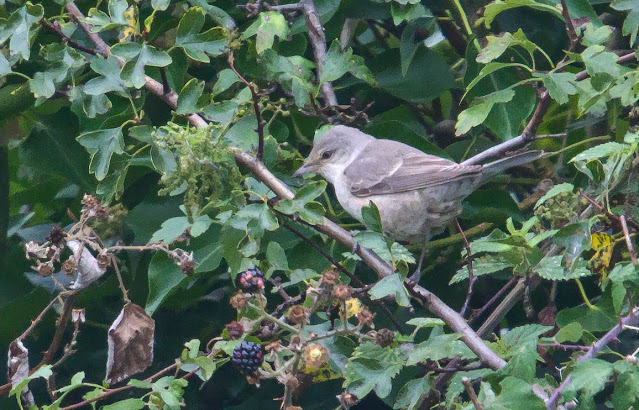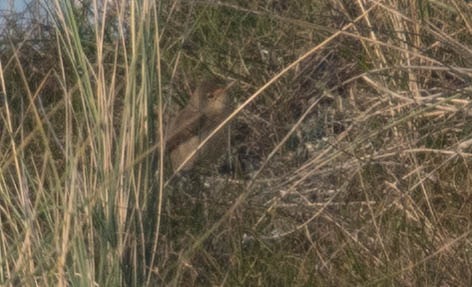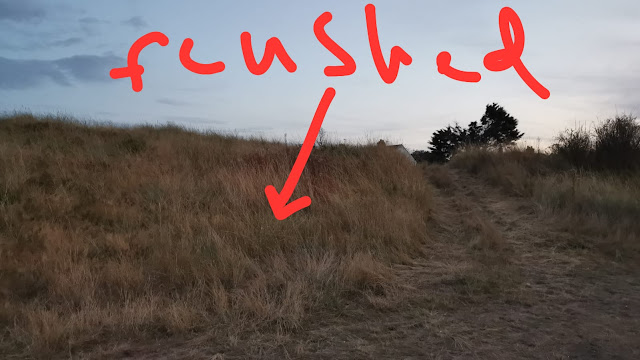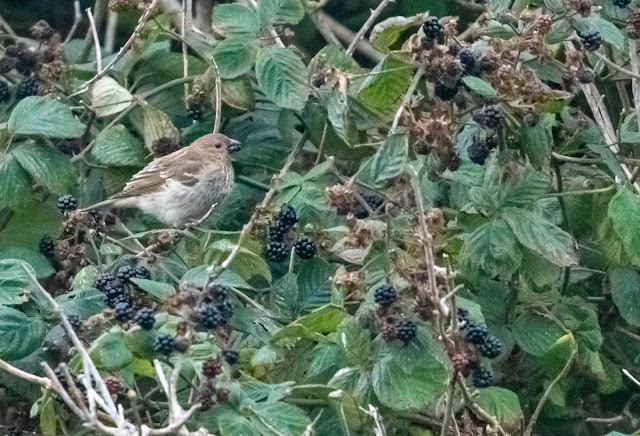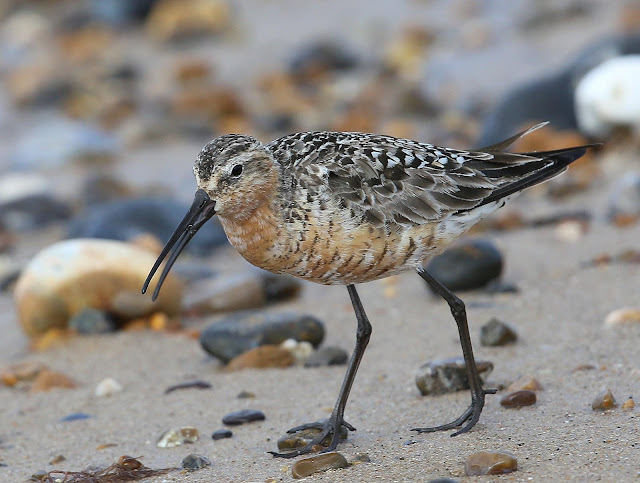November was generally an unexceptional month as the Autumn migration petered out. On the 1st seawatching was slow, with the odd Arctic Skua and Great Skua, and several Kestrels in off, including one which was tracked arriving from about two miles out. The journey took about 20 minutes and the plucky little falcon was almost caught by several Great Black-backed Gulls before making it to land.
Several Rock Pipits remained around on the north beach, and Short-eared Owls were much in evidence on the North Dunes. A few Fieldfares were beginning to arrive, with 2 in the North Dunes on the 2nd, plus a Bullfinch calling along the Holmes Road. Snow Bunting numbers built up a little, with 26 counted on the beach on the same date.
On the 3rd a Barn Owl was hunting in the North Dunes well into late morning. Also around were a singing Chiffchaff in the Birdless Bushes, a couple of Goldcrests and Coal Tits, and a Treecreeper in the Holmes Road. There was also a tern feeding off the sandbar, initially found by visiting birder Stephen H, which we eventually pinned down as a rather late Arctic Tern.
On the 4th seawatching produced big numbers of Eider - over 200 on the final count, plus several Bonxies, Goldeneye, 2 Velvet Scoter, a Goosander and a range of more common ducks. Little Gulls and Golden Plover were also seen.
On the 5th a Little Auk went north quite early on, and an eared owl, probably a Short-eared Owl, came in off rather distantly. This was followed by several more definite Short-eared Owls coming in at various times and locations through the morning. Despite plenty of Long-eareds being seen arriving in North Norfolk, ours were all Short-eareds. There had also been a slight arrival of warblers, with a Chiffchaff in Pete's garden and another one later in Colin's, a Willow Warbler below the lighthouse, and a very brief Yellow-browed Warbler seen with a small tit flock by Barry in private gardens. It wasn't seen again, although Mick heard it calling later on. There were also two Black Redstarts in the South Dunes/Hermanus area, and several Bramblings in the high trees at the Hermanus.
On the morning of the 6th, a few Siskins were moving through the valley, and there was a Brambling below the lighthouse and another (or perhaps the same one) at the Oaks. At least four Short-eared Owls were in the North Dunes, plus a ring-tail Hen Harrier and a Red Kite.
On the 7th there were at least 5 Swallows in the valley, and this slightly interesting Chiffchaff, which had a call somewhere between a normal Chiffchaff and a tristis - a single syllable but rather more optimistic than a siberian chiffy!
In the early part of the month Ted was honoured by several visits from this wonderful creature to his garden, which had presumably wandered down from its allotment cage.
A few Swallows remained in the valley on the 8th, and there was another interesting, completely brown Chiffchaff with the tit flock along the Holmes Road, plus a Treecreeper. The Chiffchaff didn't call. At least 30 Siskins were flying around Duffles Pond in the afternoon, and the Short-eared Owl count went up to a possible seven in the North Dunes.
On the 9th at least 200 Siskins went south through the valley before 9am.
On the 11th a Great-crested Grebe was sitting close inshore off the South Dunes, and a Woodcock flushed from below the Hermanus in the morning, with another flying over the village in the late afternoon.
On the 12th a Red Kite flew inland over the north wood, and a Peregrine was making the most of the huge influx of Starlings arriving in off, alongside Fieldfares and Chaffinches. Another Woodcock was flushed off the North Dunes. Another Black Redstart was hanging around on a roof on Old Chapel Road.
A Purple Sandpiper took up residence on and around the tank traps below the old cafe, and could be seen there at the right tide time for several more weeks.
Seawatching was slow still, with the odd Bonxie but not much else, although this in-off arrival on the 12th had us going for a while!
On the 14th and 15th the wind finally blew from the east, coinciding exactly with the dates we had chosen to all do conservation work in the South Dunes, removing Russian vine, so we didn't actually do much birding in the best wind of the autumn, but we did manage a little. There was another Black Redstart at the Hermanus on the 14th, and early on the 15th Barry had an excellent view of the White-billed Diver doing a close-in flyby (surely THIS will be the final view of this amazing bird). Later he and Sean had another Little Auk and a Red-breasted Merganser.
On the morning of the 16th Barry had seven Shorelarks on the north beach, but they flew south and couldn't be relocated. On the 17th Mick had a Merlin near the village and a Woodcock through the valley.
There was not much more to report as the month moved on. A ringed Herring Gull on the patch turned out to be at least 7 years old and fairly well-travelled.
This Casp-a-like Herring Gull (or maybe hybrid) was on the north beach for a couple of days too. It got us looking but its dark underwing, tertial pattern, and lack of a shawl put it firmly in the mudblood camp at best for us - although the structure was promising and the scapular moult was pretty advanced - comments are obviously very welcome from more experienced larophiles!
On the 19th sunshine brought out late butterflies (Red Admiral)and dragonflies (Migrant Hawker and Common Darter), and the first 'Autumn' Blackcap was in Pete's garden.
On the 20th Tim photographed this nice Sparrowhawk in his garden.
On the same date Chris, up from Bedfordshire for the weekend, had a Little Auk north in the late morning, as well as several Short-eared Owls in the North Dunes still. Colin also had a Green Woodpecker yaffling away.
The 22nd arrived with pretty good conditions for seawatching, and began well with a Long-tailed Duck north at 8.23am. Three Little Auks also went north during the morning, and 2 Great Skuas hunted close in. In the early afternoon these six fantastic Pale-bellied Brent Geese went north - a real rarity here. They were also seen going past Lowestoft 43 minutes earlier.
In the first hour of the afternoon more birds were moving north, including large flocks of Eider (such as this one with a passenger along for the ride).
Sean was lucky enough to see a brilliant, fairly close juvenile Sabine's Gull at 1.24pm. Interestingly, both Sean (the previous afternoon) and Barry (that morning) had seen what they thought must have been a juvenile Sabine's (seemingly brown upperwing coverts, dark outer primaries) but it had both times been too far out to clinch. This time the bird flew north well inside the Cockle Light, and showed the upperwing pattern very clearly, with the lightish brown coverts particularly obvious and extending forwards, making the bird appear dark-headed. It seems a very late record.
On the 23rd things had died down, although there was an immature Little Gull in the surf along the north beach. Pete had another (different) Blackcap in his garden and Sean found an extremely late Willow Warbler in the oak trees along the back of the Hermanus, where it was out of the wind. Getting a good photo was challenging!
The big storm Arwen arrived at the end of the month, producing an unprecedented arrival of Brunnich's Guillemots in the North Sea including one in Norfolk, so we all had high hopes of more decent seawatches but overall it didn't happen, although Barry did have a Puffin fly south on the 27th, along with a couple of Fulmars, Arctic Skuas and Great Skuas. On the 29th a Little Auk flew north in the morning, and there were a few Goldeneye, a Velvet Scoter and several Great Crested Grebes, plus an interesting Skua which two out of three observers thought might well be a Pomarine, but it was too far out to clinch.
The month petered out on the 30th with a slow seawatch, although a nice male Goosander flew inland and a distant Guillemot sitting on the sea was in full summer plumage, allowing fantasies of it drifting closer and becoming much rarer. Of course it didn't happen. At the end of the month we have collectively seen 204 species on the patch. Happy Christmas, and happy patch birding everyone!


















